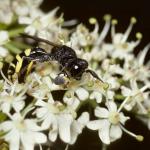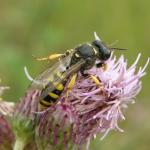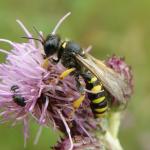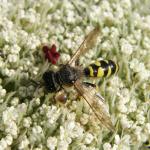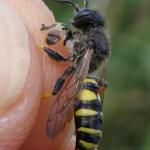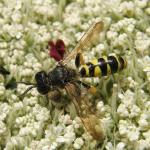Sphex patellarius (SCHREBER, 1784); Sphex argus (CHRIST, 1791); Sphex longa (CHRIST, 1791); Sphex lunatus (CHRIST, 1791); Crabro palmatus PANZER 1797; Crabro inornatus MOCSARY 1901; Crabro hypotheticus KOKUJEV, 1927
Of the three species of Crabro which occur in Britain, C. cribrarius is the largest. Male Crabro can be readily distinguished from other medium-sized British and Irish sphecids by their conspicuous fore-tibial shields.
A local species but widely distributed throughout much of Britain and the Channel Islands.
This species is not regarded as being threatened.
This wasp is mainly associated with light, sandy soils, such as lowland heaths and coastal dunes and landslips. However, it is also encountered on heavier soils, being known, for example, from open woodland and chalk grassland.
Apparently single-brooded; late June to mid-September.
Paralysed Diptera of the families Therevidae, Asilidae, Empididae, Syrphidae and the superfamily Muscoidea (Richards, 1980).
The nest burrows are excavated in the soil and extend for 15-20 cm. Each main burrow ends in a cell, and later two or three cells are constructed at the end of short, lateral branches (Lomholdt, 1976).The cells are provisioned with five to eight flies (Lomholdt, 1976). Continental nests have also been found in decayed wood (Kohl, 1915); indeed, British specimens of this wasp have occasionally been seen alighting on wood.
This species mainly visits species of umbellifers (Apiaceae), including wild angelica, wild parsnip, hogweed and wild carrot. It also visits creeping thistle.
1997


